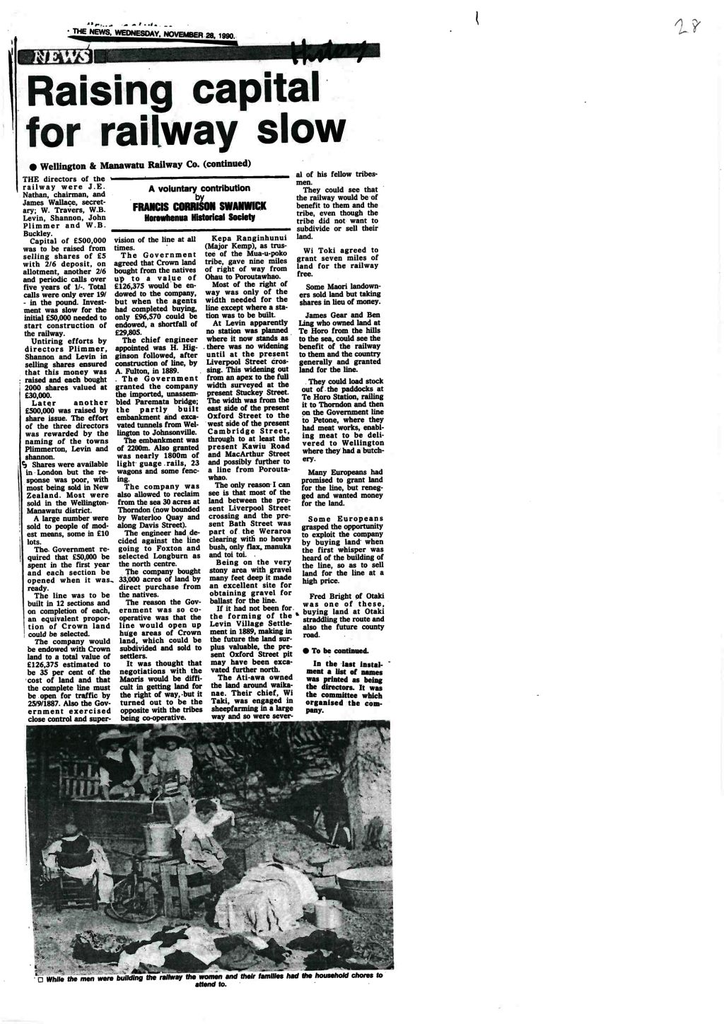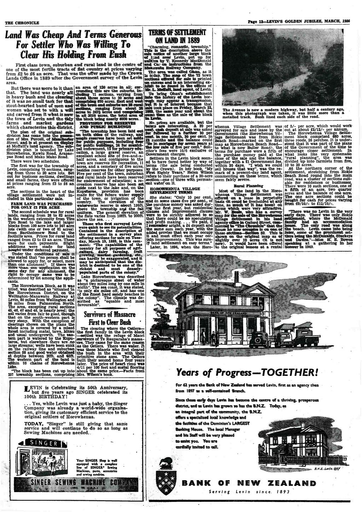Raising capital for railway slow
- Description
This text that follows is the content of the attached PDF.
Capital of £500,000 was to be raised from selling shares of £5 with 2/6 deposit, on allotment, another 2/6 and periodic calls over five years of 1/-. Total calls were only ever 19/- in the pound. Investment was slow for the initial £50,000 needed to start construction of the railway.
Untiring efforts by committee members Plimmer, Shannon and Levin in selling shares ensured that this money was raised and each bought 2000 shares valued at £30,000.
Later another £500,000 was raised by share issue. The effort of the three members was rewarded by the naming of the towns Plimmerton, Levin and Shannon.
Shares were available in London but the response was poor, with most being sold in New Zealand. Most were sold in the Wellington-Manawatu district.
A large number were sold to people of modest means, some in £10 lots.
The Government required that £50,000 be spent in the first year and each section be opened when it was ready.
The line was to be built in 12 sections and on completion of each; an equivalent proportion of Crown land could be selected.
The company would be endowed with Crown land to a total value of £126,375 estimated to be 35% of the cost of land and that the complete line must be open for traffic by 25/9/1887. Also the Government exercised close control and supervision of the line at all times.
The Government agreed that Crown land bought from the natives, up to a value of £126,375 would be endowed to the company, but when the agents had completed buying, only £96,570 could be endowed, a shortfall of £29,805.
The chief engineer appointed was H. Higginson followed, after construction of line by A. Fulton, in 1889.
The Government granted the company the imported, unassembled Paramata Bridge; the partly built embankment and excavated tunnels from Wellington to Johnsonville.
The embankment was of 2200m. Also granted was nearly 1800m of light gauge rails, 23 wagons and some fencing.
The company was also allowed to reclaim from the sea 30 acres at Thorndon (now bounded by Waterloo Quay and along David Street).
The engineer had decided against the line going to Foxton and selected Longburn as the north centre.
The company bought 33,000 acres of land by direct purchase from the natives.
The reason the Government was so cooperative was that the line would open up huge areas of Crown land, which could be subdivided and sold to settlers.
It was thought that negotiations with the Maoris would be difficult in getting land for the right of way, but it turned out to be the opposite with the tribes being co-operative.
Kepa Ranginhunui (Major Kemp), as trustee of the Mua-u-poko tribe, gave nine miles of right of way from Ohau to Poroutawhao.
Most of the right of way was only of the width needed for the line except where a station was to be built.
At Levin apparently no station was planned where it now stands as there was no widening until at the present Liverpool Street crossing. This widening out from an apex to the full width surveyed at the present Stuckey Street. The width was from the east side of the present Oxford Street to the west side of the present Cambridge Street, through to at least the present Kawiu Road and MacArthur Street and possibly further to a line from Poroutawhao.
The only reason I can see is that most of the land between the present Liverpool Street crossing and the present Bath Street was part of the Weraroa clearing with no heavy bush, only flax, manuka and toi toi.
Being on the very stony area with gravel many feet deep, it made an excellent site for obtaining gravel for ballast for the line.
If it had not been for the forming of the Levin Village Settlement in 1889, making in the future the land surplus valuable, the present Oxford Street pit may have been excavated further north.
The Ati-awa owned the land around Waikanae. Their chief, Wi Taki, was engaged in sheep farming in a large way and so were several of his fellow tribesmen.
They could see that the railway would be of benefit to them and the tribe, even though the tribe did not want to subdivide or sell their land.
Wi Toki agreed to grant seven miles of land for the railway free.
Some Maori landowners sold land but taking shares in lieu of money.
James Gear and Ben Ling who owned land at Te Horo from the hills to the sea, could see the benefit of the railway to them and the country generally and granted land for the line.
They could load stock out of the paddocks at Te Horo Station, railing it to Thorndon and then on the Government line to Petone, where they had meat works, enabling meat to be delivered to Wellington where they had a butchery.
Many Europeans had promised to grant land for the line, but reneged and wanted money for the land.
Some Europeans grasped the opportunity to exploit the company by buying land when the first whisper was heard of the building of the line, so as to sell land for the line at a high price.
Fred Bright of Otaki was one of these, buying land at Otaki straddling the route and also the future county road.
The News, November 28, 1990
Identification
- Date
- November 28, 1990
Taxonomy
- Community Tags




